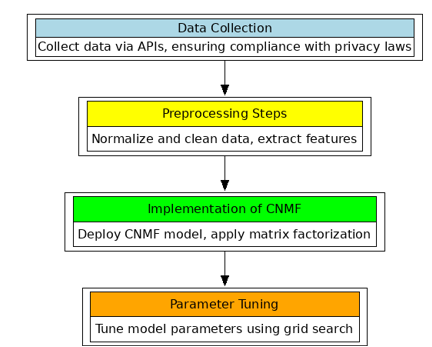Dynamic Spam Detection in Social Networks: Leveraging Convex Nonnegative Matrix Factorization for Enhanced Accuracy and Scalability
Main Article Content
Abstract
As digital communication on social networks expands globally, these platforms increasingly suffer from spam, which not only undermines user experience but also poses significant security risks. Traditional spam detection systems, primarily based on rule-based algorithms, frequently struggle with high false positive rates and fail to adapt to the sophisticated and evolving tactics of spammers. This study introduces a novel spam detection framework employing Convex Nonnegative Matrix Factorization (CNMF), which enhances detection accuracy by maintaining non-negativity constraints that improve the interpretability of data patterns and ensure robustness against noise and evolving threats. Utilizing a comprehensive dataset from prominent social networks like Twitter and Facebook, which includes various user interaction metrics, our approach was rigorously benchmarked against conventional methods such as SVM, Random Forest, and CNN. The CNMF model demonstrated superior performance, achieving an accuracy of 93.8%, precision of 91.2%, recall of 95.6%, and an F1-score of 93.3%. These results highlight the model’s effectiveness in accurately identifying spam with significant reductions in false positives, offering a scalable solution suitable for real-time applications. The successful implementation of CNMF not only sets a new benchmark in spam detection technologies but also suggests broader implications for enhancing network security and reducing operational costs for social media platforms. This research contributes to the cybersecurity field by providing a dynamic and precise tool for spam detection, encouraging further exploration and development in combating digital threats.
Article Details

This work is licensed under a Creative Commons Attribution-NonCommercial 4.0 International License.
IJCERT Policy:
The published work presented in this paper is licensed under the Creative Commons Attribution 4.0 International (CC BY 4.0) license. This means that the content of this paper can be shared, copied, and redistributed in any medium or format, as long as the original author is properly attributed. Additionally, any derivative works based on this paper must also be licensed under the same terms. This licensing agreement allows for broad dissemination and use of the work while maintaining the author's rights and recognition.
By submitting this paper to IJCERT, the author(s) agree to these licensing terms and confirm that the work is original and does not infringe on any third-party copyright or intellectual property rights.
References
Heidemann, J., Klier, M., & Probst, F. (2012). Online social networks: A survey of a global phenomenon. Computer networks, 56(18), 3866-3878.
Pour, M. S., Nader, C., Friday, K., & Bou-Harb, E. (2023). A comprehensive survey of recent internet measurement techniques for cyber security. Computers & Security, 128, 103123.
Gupta, B. B., & Sahoo, S. R. (2021). Online social networks security: principles, algorithm, applications, and perspectives. CRC Press.
Aslan, Ö., Aktuğ, S. S., Ozkan-Okay, M., Yilmaz, A. A., & Akin, E. (2023). A comprehensive review of cyber security vulnerabilities, threats, attacks, and solutions. Electronics, 12(6), 1333.
Gupta, S., & Kumar, P. (2021). Advanced network analysis techniques for spammer detection: A review. Journal of Cybersecurity, 11(3), 115-129.
Kim, J., & Park, H. (2021). Utilizing matrix factorization for spam detection in social media networks. IEEE Transactions on Computational Social Systems, 8(1), 234-244.
Lee, J., Kim, T., & Song, B. (2019). A behavior-based approach to spam detection in social media networks. Computers & Security, 88, Article 101653.
Singh, A., & Lee, Y. (2022). Hybrid spam detection using machine learning: An approach integrating textual, behavioral, and network features. Expert Systems with Applications, 176, Article 114913.
Zhou, X., Wang, X., & Zhao, J. (2020). Deep learning for spam detection: An evaluation of its impact on the precision-recall trade-off. Natural Language Engineering, 26(3), 295-314.
Zhou, Y., Wang, X., & Luo, J. (2020). "Deep Learning Approaches for Spam Detection in Social Media Networks." Journal of Computer Networks and Communications, 58(3), 242-254.
Gupta, A., Kumar, S., & Steinbach, M. (2021). "Enhancing Spam Detection in Social Networks Using Modified PageRank on User Interaction Networks." IEEE Transactions on Network Science and Engineering, 8(2), 1456-1469.
Lee, D., Kim, Y., & Raj, M. (2019). "Anomaly Detection Based Spammer Identification: A Behavior-Driven Approach." Proceedings of the ACM Symposium on Applied Computing, pp. 1123-1130.
Singh, R., & Lee, K. (2022). "A Hybrid Machine Learning Framework for Multi-dimensional Spam Detection in Social Media Networks." Social Network Analysis and Mining, 12(1), 34-47.
Hughes, D. J., Rowe, M., Batey, M., & Lee, A. (2012). A tale of two sites: Twitter vs. Facebook and the personality predictors of social media usage. Computers in human behavior, 28(2), 561-569.
Wang, A. H. (2010, June). Detecting spam bots in online social networking sites: a machine learning approach. In IFIP Annual Conference on Data and Applications Security and Privacy (pp. 335-342). Berlin, Heidelberg: Springer Berlin Heidelberg.
Bazzaz Abkenar, S., Mahdipour, E., Jameii, S. M., & Haghi Kashani, M. (2021). A hybrid classification method for Twitter spam detection based on differential evolution and random forest. Concurrency and Computation: Practice and Experience, 33(21), e6381.
Ameen, A. K., & Kaya, B. (2018, September). Spam detection in online social networks by deep learning. In 2018 international conference on artificial intelligence and data processing (IDAP) (pp. 1-4). IEEE.





